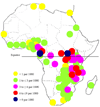Substantial regional differences in human herpesvirus 8 seroprevalence in sub-Saharan Africa: insights on the origin of the "Kaposi's sarcoma belt"
- PMID: 20143397
- PMCID: PMC2895015
- DOI: 10.1002/ijc.25235
Substantial regional differences in human herpesvirus 8 seroprevalence in sub-Saharan Africa: insights on the origin of the "Kaposi's sarcoma belt"
Abstract
Equatorial Africa has among the highest incidences of Kaposi's sarcoma (KS) in the world, thus earning the name "KS Belt." This was the case even before the HIV epidemic. To date, there is no clear evidence that HHV-8 seroprevalence is higher in this region but interpretation of the available literature is tempered by differences in serologic assays used across studies. We examined representatively sampled ambulatory adults in Uganda, which is in the "KS Belt," and in Zimbabwe and South Africa which are outside the Belt, for HHV-8 antibodies. All serologic assays were uniformly performed in the same reference laboratory by the same personnel. In the base-case serologic algorithm, seropositivity was defined by reactivity in an immunofluorescence assay or in 2 enzyme immunoassays. A total of 2,375 participants were examined. In Uganda, HHV-8 seroprevalence was high early in adulthood (35.5% by age 21) without significant change thereafter. In contrast, HHV-8 seroprevalence early in adulthood was lower in Zimbabwe and South Africa (13.7 and 10.8%, respectively) but increased with age. After age adjustment, Ugandans had 3.24-fold greater odds of being HHV-8 infected than South Africans (p < 0.001) and 2.22-fold greater odds than Zimbabweans (p < 0.001). Inferences were unchanged using all other serologic algorithms evaluated. In conclusion, HHV-8 infection is substantially more common in Uganda than in Zimbabwe and South Africa. These findings help to explain the high KS incidence in the "KS Belt" and underscore the importance of a uniform approach to HHV-8 antibody testing.
Conflict of interest statement
Potential conflicts of interest. All authors: no conflicts.
Figures
References
-
- Ziegler JL. Endemic Kaposi's sarcoma in Africa and local volcanic soils. Lancet. 1993;342:1348–1351. - PubMed
-
- Chang Y, Cesarman E, Pessin MS, Lee F, Culpepper J, Knowles DM, Moore PS. Identification of herpesvirus-like DNA sequences in AIDS-associated Kaposi's sarcoma. Science. 1994;266:1865–1869. - PubMed
-
- Whitby D, Howard MR, Tenant-Flowers M, Brink NS, Copas A, Boshoff C, Hatzioannou T, Suggett FE, Aldam DM, Denton AS, et al. Detection of Kaposi sarcoma associated herpesvirus in peripheral blood of HIV-infected individuals and progression to Kaposi's sarcoma. Lancet. 1995;346:799–802. - PubMed
-
- Gao SJ, Kingsley L, Hoover DR, Spira TJ, Rinaldo CR, Saah A, Phair J, Detels R, Parry P, Chang Y, Moore PS. Seroconversion to antibodies against Kaposi's sarcoma-associated herpesvirus-related latent nuclear antigens before the development of Kaposi's sarcoma. N Engl J Med. 1996;335:233–241. - PubMed
Publication types
MeSH terms
Grants and funding
LinkOut - more resources
Full Text Sources
Other Literature Sources
Medical


